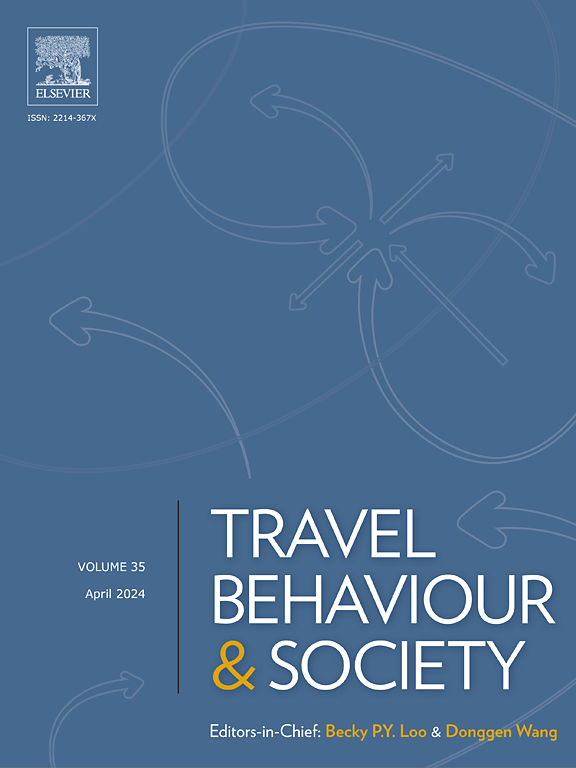网络购物中送货上门和提货上门的空间动力学
IF 5.7
2区 工程技术
Q1 TRANSPORTATION
引用次数: 0
摘要
尽管网上购物越来越受欢迎,但最后一英里送货方式仍然是交通行业的一个关键问题。了解订单收集方法的选择对于预测出行需求、拥堵和排放非常重要。本研究调查了最后一英里订单收集方式的选择,包括1)送货上门和2)点击取货(C&;P)。数据来自葡萄牙波尔图大都会区的一家连锁超市,其中包括2022年1月至6月6个月的在线杂货订单数据,涉及116,984个订单。本研究采用潜类二元logit模型(LBL)。该模型通过将个体分配到离散的潜在类别来捕获未观察到的异质性。基于拟合优度度量,对两类模型进行估计。第1类主要代表郊区的消费者,而第2类代表城市地区的消费者。结果表明,单次订单的总数量、平均通勤时间、婚姻状况、居住状况、单亲家庭比例、公交车站、杂货店和商场的平均距离对送货上门和送货上门的偏好有影响。结果表明,郊区和城市社区之间存在显著的异质性,郊区租房者和郊区已婚人群对送货上门的偏好低于城市人群。弹性效应表明,投送方式偏好对社会人口因素的敏感性中等,而对可达性特征的敏感性为零。研究结果预计将有助于了解最后一英里在线订单收集方法的选择,包括优先考虑送货上门和取货设施的领域,以及制定公平的运输计划和政策。本文章由计算机程序翻译,如有差异,请以英文原文为准。
Spatial dynamics of home delivery and pick-up in online shopping
Despite the growing popularity of online shopping, the last-mile delivery method is still a critical problem in the transportation industry. Understanding the choice of order collection methods is important to predicting travel demand, congestion, and emissions. This study investigates the choice of last mile order collection method, which includes 1) home delivery and 2) click and pick up (C&P). Data comes from a superstore chain in the Porto Metropolitan Area from Portugal, which includes 6 months of online grocery order data between January and June 2022 – involving 116,984 orders. The study employs a latent class binary logit model (LBL). The model captures unobserved heterogeneity by assigning individuals into discrete latent classes. Based on goodness-of-fit measures, the model is estimated for two classes. Class 1 predominantly represents consumers in suburban areas, whereas class 2 represents consumers from urban areas. Results reveal that the total number of boxes per order, average commute time, marital status, dwelling status, the proportion of single-parent families, and average distances of bus stop, grocery, and mall contribute to the preference for home delivery and C&P. Results indicate significant heterogeneity between suburban and urban neighborhoods, with suburban renters and suburban married populations showing a lesser preference for home delivery than their urban counterparts. The elasticity effect suggests that the delivery method preference is moderately sensitive to sociodemographic factors, whereas little to zero sensitive to accessibility features. The findings are expected to assist in understanding choices for the last-mile online order collection methods, including areas to prioritize for home delivery and pick-up facilities, as well as developing equitable transportation plans and policies.
求助全文
通过发布文献求助,成功后即可免费获取论文全文。
去求助
来源期刊

Travel Behaviour and Society
TRANSPORTATION-
CiteScore
9.80
自引率
7.70%
发文量
109
期刊介绍:
Travel Behaviour and Society is an interdisciplinary journal publishing high-quality original papers which report leading edge research in theories, methodologies and applications concerning transportation issues and challenges which involve the social and spatial dimensions. In particular, it provides a discussion forum for major research in travel behaviour, transportation infrastructure, transportation and environmental issues, mobility and social sustainability, transportation geographic information systems (TGIS), transportation and quality of life, transportation data collection and analysis, etc.
 求助内容:
求助内容: 应助结果提醒方式:
应助结果提醒方式:


